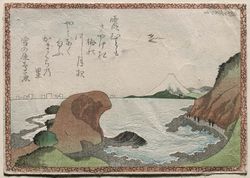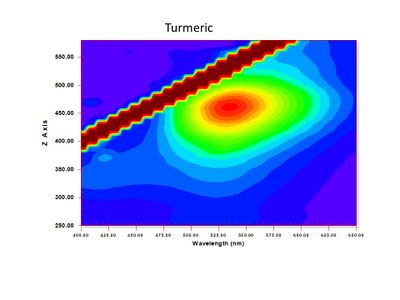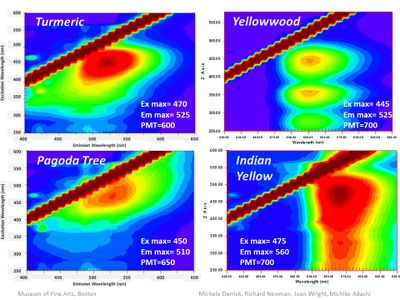Difference between revisions of "Category:Indigo/Orpiment: Ukiyo-e colorant"
Jump to navigation
Jump to search
| Line 42: | Line 42: | ||
== Analysis == | == Analysis == | ||
| − | Fiber optic reflectance spectroscopy (FORS) and (XRF) is used to identify indigo+orpiment. | + | Fiber optic reflectance spectroscopy (FORS) and X-ray fluorescence analysis (XRF) is used to identify indigo+orpiment. |
<gallery mode="packed" heights="200px" style="text-align: left"> | <gallery mode="packed" heights="200px" style="text-align: left"> | ||
Turmeric EEM ref.jpg|<center>3D EEM plot for Turmeric</center> | Turmeric EEM ref.jpg|<center>3D EEM plot for Turmeric</center> | ||
Revision as of 01:01, 1 June 2020
Indigo + Orpiment: Green is achieved by mixing or overprinting a blue and a yellow colorant. The most common combination found is indigo and orpiment. It appears that printers were able to create a wide range of greens with these two colorants. It also appears that printers also settled on indigo+orpiment as the go to green.
For more information see: Indigo, Orpiment
Examples of Indigo+Orpiment in Ukiyo-e Prints

|

|

|

|

|
Analysis
Fiber optic reflectance spectroscopy (FORS) and X-ray fluorescence analysis (XRF) is used to identify indigo+orpiment.
List of Prints
List of prints where indigo was detected
Pages in category "Indigo/Orpiment: Ukiyo-e colorant"
The following 58 pages are in this category, out of 58 total.
E
- Eisen, Fujieda: Kichô of the Owariya, from the series A Tôkaidô Board Game of Courtesans: Fifty-three Pairings in the Yoshiwara, 11.17946
- Eisen, Geisha at Night under Plum Blossoms, 11.26691-2
- Eisen, Kawasaki, No. 3 from an untitled series of the Fifty-three Stations of the Tôkaidô Road, 11.25617
- Eisen, Minazuru-hime as Ono no Komachi and Benkei as Kisen Hôshi, from the series Characters from the Life of Ushiwaka as the Six Poetic Immortals, 11.25669
- Eisen, The Song Evening Mist at Asama Peak, on Scrap-paper Fabric with an Itchû-bushi Libretto, from the series A Modern Pine Needle Collection, 11.17878
- Eishi, Shizuka of the Shizutamaya, from the series Beauties of the Yoshiwara as Six Floral Immortals, 21.4917
- Eishi, Utamaki of the Takeya, kamuro Futaba and Midori, from the series New Year Fashions as Fresh as Young Leaves, 34.336
- Eizan, Kashiku of the Tsuruya, from the series Array of Beauties of the Pleasure Quarters, 11.17716
H
- Harunobu, Courtesan Watching Two Kamuro Make a Snow Dog, 21.4463
- Harunobu, Ebisu and Ofuji, from the series The Seven Gods of Good Fortune in the Modern World, 34.343
- Harunobu, Nishikigi of the Kanaya Lighting Incense beside a Mosquito Net, 11.16479
- Harunobu, Osen of the Kagiya and a Young Man with a Cat, 11.19496
- Harunobu, Poem by Saigyô Hôshi, from an untitled series of Three Evening Poems, 34.348
- Harunobu, Young Man Playing a Shakuhachi, 21.4677
- Harunobu, Young Woman Riding a Turtle (Parody of the Story of Urashima Tarô), 21.4594
- Hiroshige I, Naitô Shinjuku, Yotsuya, from the series One Hundred Famous Views of Edo, 11.35823
- Hokkei, Goat Standing by a Plum Tree, 21.9277
- Hokkei, Ômori, from the series Souvenirs of Enoshima, a Set of Sixteen, 11.19845
- Hokusai, Woman, Child, and Man with Kite, from the series A Collection of Dances, 11.16764
K
- Kiyohiro, Two Children Playing with Hobbyhorses, 11.19047
- Kiyomasu II, Actor Segawa Kikunojô I in Momo Chidori Musume Dôjô-ji, 06.423
- Kiyomasu II, Actors Segawa Kikunojô I as Ochiyo; Matsushima Kichisaburô as Ochiyo's Spirit Projection, the Courtesan Tekkai Sennin; and Ichikawa Ebizô II as Mushanosuke of Ôsaka, 21.5452
- Kiyomasu II, Actors Tamazawa Saijirô as the Courtesan Chidori and Ichimura Manzô as Takigô Tôshichi; Calendar for 1744, 21.5455
- Kiyomasu II, Actors Ôtani Hiroji II as Washi no Chôkichi and Arashi Tominosuke as Tarui Osen, 21.5458
- Kiyomasu II, The Arrival of the Elephant, 58.343
- Kiyonaga, A Matchmaking Meeting at a Teahouse by a Shrine, 21.5574
- Kiyonaga, Actors Matsumoto Kôshirô IV as Ukita Sakingo and Sawamura Sôjûrô III as the Ghost of Takao, with chanters Tomimoto Itsukidayû and Tomimoto Awatayû, and accompanist Sasaki Ichishirô, 11.13921
- Kiyonaga, Actors Matsumoto Kôshirô IV as Ukita Sakingo and Sawamura Sôjûrô III as the Ghost of Takao, with chanters Tomimoto Itsukidayû and Tomimoto Awatayû, and accompanist Sasaki Ichishirô, 21.5476
- Kiyonaga, The Brine Maidens, from the series Current Manners in Eastern Brocade, 11.13880
- Kiyonaga, The Brine Maidens, from the series Current Manners in Eastern Brocade, 21.5610
- Kiyonaga, Women Visiting Enoshima, 11.21277
- Kokan, Couple Cooling Off on a Garden Bench, 11.19524
- Koryusai, Twilight Snow of the Bride, from the series Eight Views of Fashionable Human Relations, 11.19541
- Kunisada, Actor Nakamura Utaemon III as the Monkey Trainer Yojirô, from the series Great Hit Plays, 11.15095
- Kunisada, Actor Sawamura Tanosuke II, from the series Actor Rebuses, 11.42324
- Kunisada, Actors Iwai Kumesaburô II as Agemaki (R), Ichikawa Danjûrô VII as Sukeroku (C), and Onoe Kikugorô III as Shinbei (L), 21.7532-4
- Kunisada, Komurasaki of the Kado-Tamaya, kamuro Kochô and Sayuri, from the series Comparison of Beauties of the Pleasure Quarters, 11.20991
- Kunisada, Moon Viewing at Mukôjima, a Triptych, from the series Moon, Snow and Flowers, 11.15216
- Kunisada, Poem by Ariwara no Narihira Ason: (Actor Ichikawa Danjûrô VIII as) Seigen, from the series Comparisons for Thirty-six Selected Poems, 11.42663
- Kunisada, Young Woman Pointing and Giggling, from the series Types of the Floating World Seen through a Physiognomist's Glass, 34.471
- Kuniyoshi, Actor Ichikawa Kodanji IV as the Ghost of Asakura Tôgo, 11.30460
- Kuniyoshi, Ruan Xiaowu, the Short-lived Second Son, from the series One Hundred and Eight Heroes of the Popular Shuihuzhuan, 64.800
- Kuniyoshi, Takeout Sushi Suggesting Ataka, from the series Women in Benkei-checked Fabrics, 11.36360
- Kuniyoshi, The Ninth Hour: Noon; Woman Playing with Cat, Fishmonger and Dog, from the series Sundial of Modern Tradesmen, 11.15955
- Kuniyoshi, Tsumagome: Abe no Yasuna and the Fox Kuzunoha, from the series Sixty-nine Stations of the Kisokaidô Road, 11.41803
S
- Sharaku, Actor Osagawa Tsuneyo II as Ippei's Older Sister Osan, 11.14673
- Sharaku, Actor Osagawa Tsuneyo II as Ippei's Older Sister Osan, 11.14674
- Sharaku, Actor Osagawa Tsuneyo II as Ippei's Older Sister Osan, 21.7244
- Shinsai, Chapters 16–18, from the series The Tale of Genji, 11.21066
- Shinsai, Chapters 22–24, from the series The Tale of Genji, 11.20034
- Shinsai, Chapters 25–27, from the series The Tale of Genji, 21.9264
- Shunman, Mandarin Ducks and Iris, from the series Series of Seven Bird-and-Flower Prints for the Fuyô Circle of Kanuma in Shimotsuke Province, 21.9226
- Shunshō, No. 3, Comparative Poems, from the series Six Types of Waka Poetry as Described in the Preface of the Kokinshû, 11.19295



